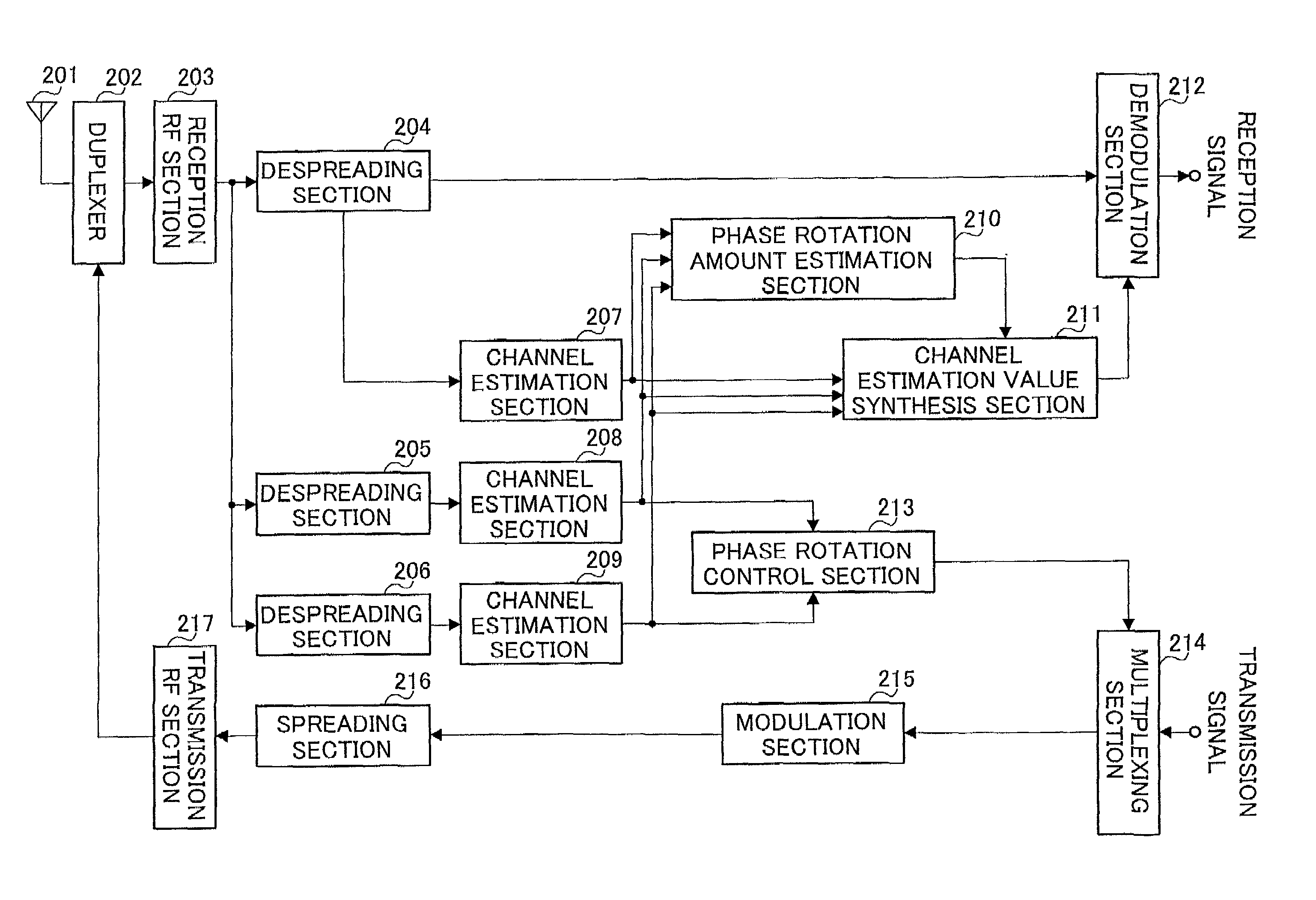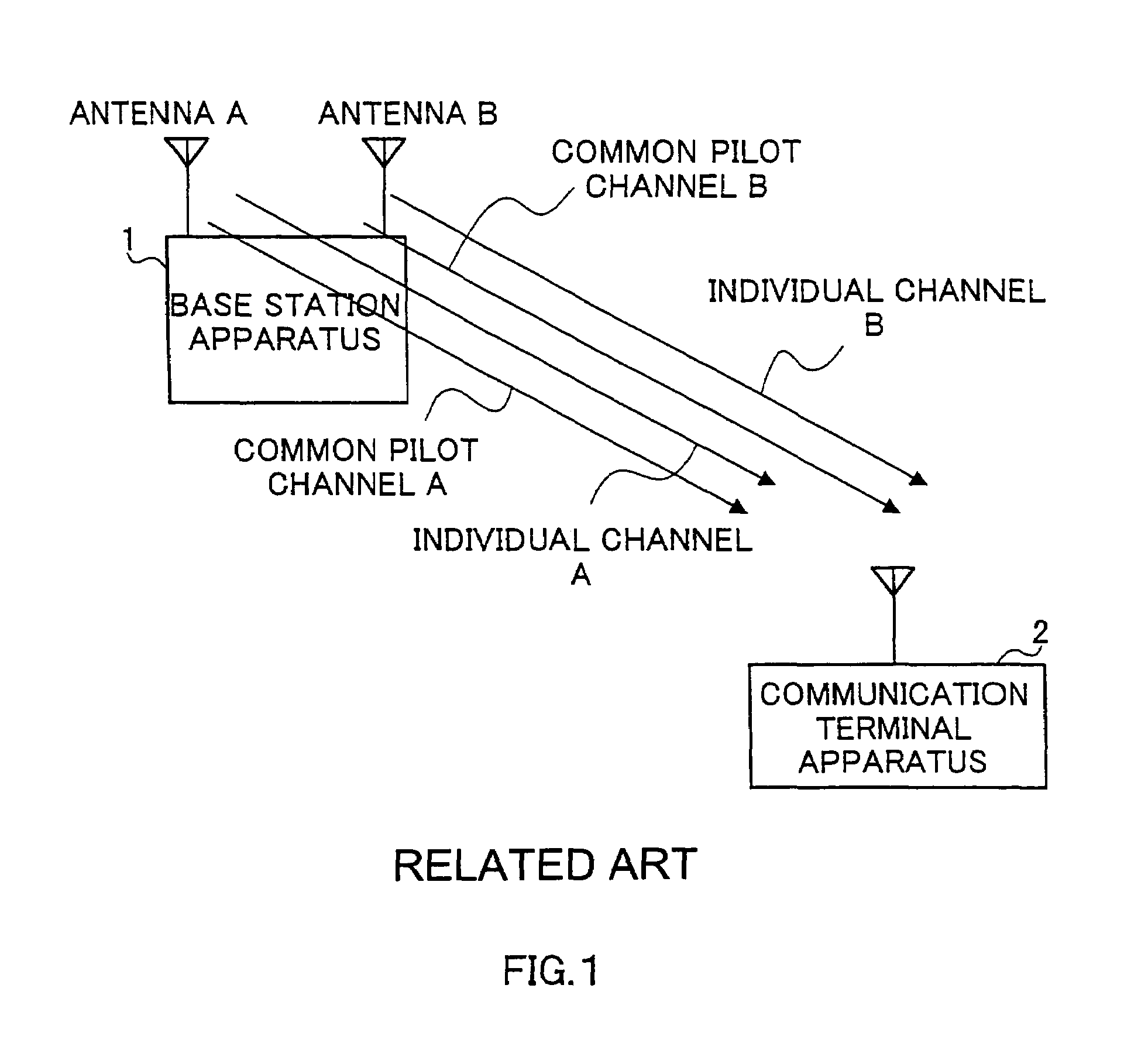Communication terminal device and channel estimating method
a terminal device and channel estimation technology, applied in multiplex communication, wireless communication, baseband system details, etc., can solve the problem of reducing the reliability of channel estimation values compared to a case of transmission diversity, and achieve the effect of improving the reliability of channel estimation values
- Summary
- Abstract
- Description
- Claims
- Application Information
AI Technical Summary
Benefits of technology
Problems solved by technology
Method used
Image
Examples
embodiment 1
[0045]Embodiment 1 will describe a case where the base station transmits individual channel signal A and individual channel signal B without changing their amplitudes.
[0046]FIG. 5 is a block diagram showing a configuration of a communication terminal according to Embodiment 1 of the present invention.
[0047]In the communication terminal shown in FIG. 5, antenna 201 receives a signal transmitted from the base station and sends a signal to the base station. Duplexer 202 switches between time zones of transmission and reception. Reception RF section 203 amplifies the reception signal that passes duplexer 202 and converts the frequency of the reception signal to a baseband signal.
[0048]Despreading section 204 despreads the output signal of reception RF section 203 with a spreading code of an individual channel signal and extracts a modulated signal of the individual channel signal. Likewise, despreading section 205 despreads the output signal of reception RF section 203 with a spreading ...
embodiment 2
[0079]Embodiment 2 will describe a case where the base station carries out transmission by changing the amplitudes of individual channel signal A and individual channel signal B.
[0080]The relationship of channel estimation values in this embodiment will be explained using FIG. 7.
[0081]Suppose the base station sets the amplitude of individual channel signal B “a” times (hereinafter this “a” will be referred to as “amplitude coefficient”) the amplitude of individual channel signal A. When the amplitude ratio of αa(n) to βa(n) is assumed to be k, the amplitude ratio of αb(n) to βb(n) is (k×a).
[0082]In this case, as shown in FIG. 7, channel estimation value β(n) of an individual channel signal and synthesis value α(n) of common pilot channel signal A and common pilot channel signal B do not point in the same direction.
[0083]Thus, when the base station carries out transmission by changing the amplitudes of individual channel signal A and individual channel signal B, α(n) cannot be used a...
embodiment 3
[0091]When a maximum Doppler frequency of fading is low and a fading variation is moderate, it is possible to improve the reliability of channel estimation values by averaging fading estimation values over a plurality of reception slots.
[0092]However, as described above, when transmission diversity is introduced to a radio communication system, reception slots become discontiguous, and therefore it is not possible to average channel estimation values over a plurality of slots.
[0093]Embodiment 3 is intended to solve this problem and describes a case where transmission diversity is introduced and channel estimation values are synthesized over a plurality of slots.
[0094]FIG. 9 is a block diagram showing a configuration of a communication terminal according to Embodiment 3 of the present invention. In the communication terminal shown in FIG. 9, the same components as those in the communication terminal in FIG. 5 will be assigned the same reference numerals as those in FIG. 5 and explana...
PUM
 Login to View More
Login to View More Abstract
Description
Claims
Application Information
 Login to View More
Login to View More - R&D
- Intellectual Property
- Life Sciences
- Materials
- Tech Scout
- Unparalleled Data Quality
- Higher Quality Content
- 60% Fewer Hallucinations
Browse by: Latest US Patents, China's latest patents, Technical Efficacy Thesaurus, Application Domain, Technology Topic, Popular Technical Reports.
© 2025 PatSnap. All rights reserved.Legal|Privacy policy|Modern Slavery Act Transparency Statement|Sitemap|About US| Contact US: help@patsnap.com



